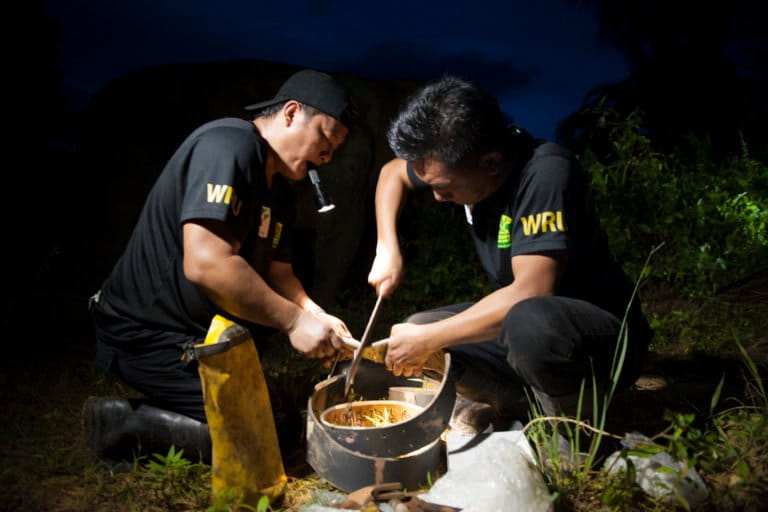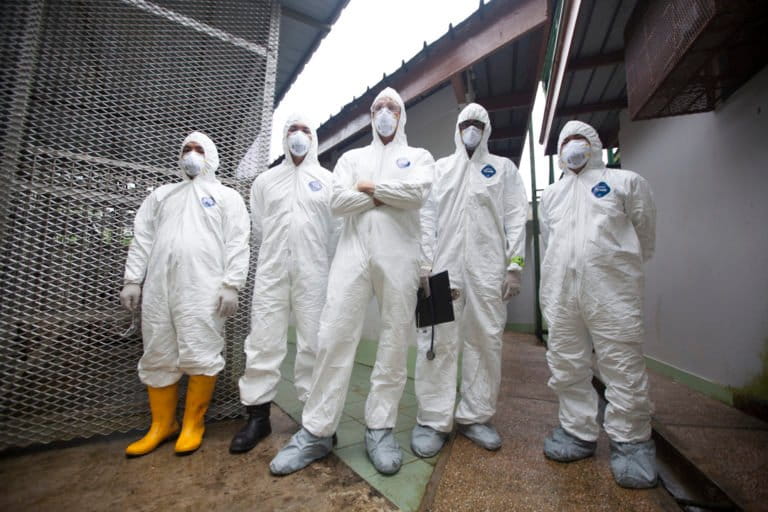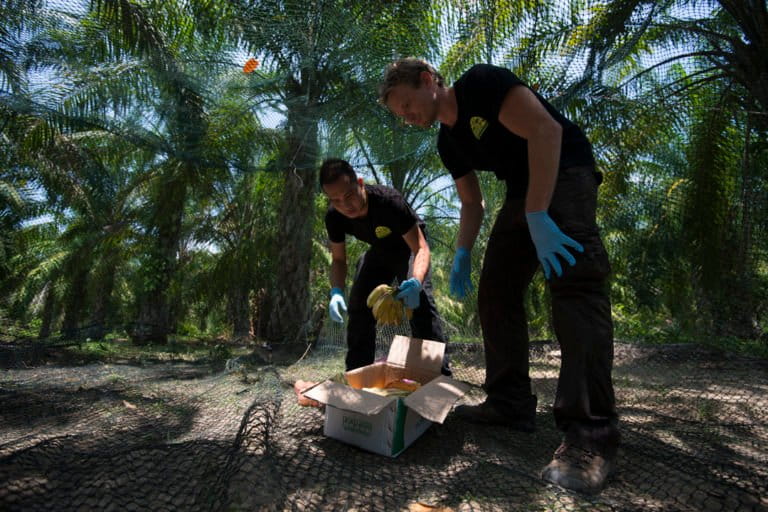- After graduating from school, Aaron ‘Bertie’ Gekoski was on a fairly conventional career path for a young businessman.
- But the more successful his agency became, the more Gekoski felt like something was missing.
- So he quit the business and embarked on a totally new adventure: wildlife filmmaking.
- Gekoski spoke about his unusual career path, his passion, and filmmaking during an April 2017 interview with Mongabay.com.
After graduating from school, Aaron “Bertie” Gekoski was on a fairly conventional career path for a young businessman, starting out in copyediting for a magazine before launching a modeling agency in London. But the more successful his agency became, the more Gekoski felt like something was missing. So he quit the business and embarked on a totally new adventure: wildlife filmmaking and photojournalism.
Today, instead of night clubs and fashion shoots, Gekoski prowls the planet’s oceans and rainforests for wildlife stories for Scubazoo, producing films that highlight the beauty and wonder of nature. His latest project — Borneo Wildlife Warriors — takes him into the rainforests of Borneo with the Sabah Wildlife Department’s Wildlife Rescue Unit, an agency charged with protecting and rehabilitating the Malaysian state’s animals.
Gekoski spoke about his unusual career path, his passion, and Borneo Wildlife Warriors during an April 2017 interview with Mongabay.com.


AN INTERVIEW WITH BERTIE GEKOSKI
Mongabay.com What is your background and what inspired you to get into wildlife film production?
Bertie Gekoski: I studied advertising and worked as a copywriter for publishing houses in London, before starting up a modeling agency with my best mate from school. After a few years doing this, it all got a bit much: tax returns, demanding clients, moaning models, a mortgage. Then I remember playing the ‘Alter Ego Game’ with my family at Christmas. In a parallel universe I would have been David Attenborough, or another of the great explorers. It was a lightbulb moment: why spend your life fantasizing about someone else’s? So I went away and discovered diving, before enlisting in the Wildlife Film Academy in the Kruger Park in 2009. I’ve never looked back.
The lifestyle is very seductive and has become something of a drug. The more you travel, the more you learn, the more you realize what a critical point we’re at in history. Our oceans are rising, warming, used as dumping grounds, and catastrophically overfished. Every year we chop down billions of trees and we lose thousands of species due to the activities of mankind. I began traveling extensively in Africa, documenting these issues as a photojournalist. It’s only the last couple of years I’ve stepped in front of the lens, when I was approached by Scubazoo CEO Simon Christopher about coming to Borneo and fronting up shows for SZtv.
The camera is one of the most potent weapons ever invented, and wielded correctly can be used as a force for good. Our goal is to take these complex issues, package them up, and make them accessible to global audiences through the media. Many view conservation as depressing or for anoraks – however it can be exciting and even entertaining. We’ve a very talented team here, creating compelling content.
Mongabay.com You’ve done a lot of work on marine wildlife and ecosystems. What prompted you to launch this series focusing on terrestrial conservation?
Bertie Gekoski: I’ve also done a lot of work on terrestrial conservation, particularly with the African elephant. When shooting our underwater series Borneo from Below, I heard about a mass poisoning event in Borneo back in 2013 that wiped out an entire herd. I started researching the elephant situation here: elephants are losing their homes to deforestation and development, are being shot and poisoned, are dying in manmade quarries, and are leaving behind their young in plantations. This brought me to the work of the Wildlife Rescue Unit (WRU), a team of dedicated vets and rangers who are doing their best to mitigate this conflict in the state of Sabah, Malaysian Borneo.
However, rather than simply covering the story as a journalist, I wanted to actually get out on the frontline of conservation. So I approached the head of the WRU, Dr. Sen Nathan, about joining his team. Dr Sen agreed and enlisted me in a ‘Boot Camp’ before I was allowed out on proper rescues and relocations. Episodes 1-6 details my time training with the WRU, whereas episodes 7 and onwards are in the field.


Mongabay.com What are the biggest challenges with this kind of filmmaking?
Bertie Gekoski: Filming in the jungle is a very different experience to shooting underwater. First of all it is hot, sweaty and full of mosquitoes. Then there’s the WRU’s work, which is exhausting and at times dangerous. Once we were charged by an elephant we’d been trying to catch for a week, and a couple of days later a baby orang-utan tried to attack me. You might work for days on end with very little sleep, yet still have to keep your wits about you if you’re pursuing a two-ton elephant. Then once you’ve caught it you still have to lead it into a cage, load it onto a truck, and transport it to a stretch of jungle far away from human settlements. It’s a little different to cruising around beautiful coral reefs photographing fish!
I have so much respect for the WRU who work under very difficult circumstances, trying to protect Borneo’s wildlife. They face many challenges: from deforestation and development, to the traditional medicine trade, the illegal pet trade and more. Dealing with constant conflict takes its toll physically and mentally, but they handle the pressure admirably.


Mongabay.com What was the most memorable moment in the making of this series?
Bertie Gekoski: So much happens in the series it’s hard to pick one moment! Along with the hairy encounters mentioned above, I learn how to handle pythons and elephants, adopt a sick pangolin, attend a sun bear medical and more. I became very attached to the gibbons, who are victims of the illegal pet trade – in particular one female called Lilo. It’s easy to see why as they’re very affectionate and beyond adorable. However once kept as pets, rehabilitation is difficult as they ‘imprint’ on their owners and become too trusting of humans. That’s why most can’t be released back into the wild.


Mongabay.com You’ve release this as a webisodes freely accessible to everyone. How are you marketing/promoting these and what is your primary target audience for this series?
Bertie Gekoski: All of our episodes are released via Facebook and are uploaded to our website via YouTube. Finding funders is a challenge, particularly as our series are high end and not cheap to produce. Borneo Wildlife Warriors was primarily funded in-house and through one donor, an American philanthropist called Damon Copeland. We have just launched an “Executive Producer Experience” to tempt in funders who have the opportunity to attend shoots, get photography/video lessons, and be listed as Executive Producer in our shows. We are also looking to work with brands that want to be associated with SZtv.
The feedback we’re getting is that our shows have a very broad appeal – kids love them, as well as older generations (our producer’s great auntie Doreen is one of our biggest fans!). It’s important to reach new audiences as we don’t just want to preach to the converted.


Mongabay.com What do you hope viewers take away from this project?
Bertie Gekoski: We are dealing with some multifaceted and sensitive subjects. It’s not always black and white or a case of good vs bad – there are many shades of grey. So we are trying to provide a balanced viewpoint, without wagging fingers at people. Palm oil, for example, receives terrible press worldwide. However, it’s one of Malaysia’s biggest exports and is a critical part of the economy. It’s unsustainably sourced palm oil that’s the major problem.
We also want to bring attention to some of the lesser-known animals. Whilst the flagship species such as orang-utans dominate the precious column inches dedicated to conservation, other creatures are faring just as badly. Pangolins are now the most trafficked mammal in the world and poaching is pushing them to the brink of extinction – yet if you asked the general public, not many would know what a pangolin was. The overall goal of the series is to highlight the problems facing Borneo’s wildlife and showcase the local heroes who dedicate their lives to mitigating these conflicts.


Mongabay.com What’s next for you?
Bertie Gekoski: SZtv have rather a lot on at the moment. We’ve just finished a 6-part series for Smithsonian (also covering the work of the WRU) called Borneo Wildlife Rescue. That comes out later this year. We are currently in the middle of shooting a new series, Borneo Jungle Diaries, which looks at the cutting edge scientific work of the Danau Girang Field Centre. This will be released on 5th June, World Environment Day, as part of our global efforts to connect people with nature. We are also editing together a feature documentary on human-elephant conflict for a series called On the Brink, and are shooting episode 2 – on Pacific leatherbacks – one of the last true dinosaurs left on Earth. We plan to tag nesting females with satellite tags later this year and follow them to where they’re still hunted with spears from dug out canoes in remotest Indonesia. With their populations plummeting from around 120,000 individuals just two decades ago to less than 3000 now due to over-fishing and by-catch, Scubazoo’s been chasing this story for almost two decades so it’s hugely exciting!
In terms of underwater productions, Next month we start production on Season 1 of Indonesia from Below in May, off the coast of Kalimantan – this includes whale sharks, mantas, and a unique jellyfish lake. We will shoot the rest of the series towards the end of this year. I’m also talking to Sea Shepherd about potentially joining them on one of their shark finning campaigns. My year is jam packed until January…but bring it on!
Subscribe to SZtv’s YouTube channel so you never miss an episode.
All images courtesy of scubazooimages.com.
![Borneo Wildlife Warriors | Official Trailer [4K] | SZtv](https://i.ytimg.com/vi/Zc0Voo4n2ns/hqdefault.jpg)
![Elephant Tragedy Sparks Photojournalist's Quest [4K] | Borneo Wildlife Warriors (S01E01) | SZtv](https://i.ytimg.com/vi/CU_MP0Daeeg/hqdefault.jpg)
![Enlisting in the Wildlife Rescue Unit [4K] | Borneo Wildlife Warriors (S01E02) | SZtv](https://i.ytimg.com/vi/IdUazIE01Ng/hqdefault.jpg)
![Gibbons and the Illegal Pet Trade [4K] | Borneo Wildlife Warriors (S01E03) | SZtv](https://i.ytimg.com/vi/BUoE-ZO8VQ0/hqdefault.jpg)
![Wrangling the World’s Longest Reptile [4K] | Borneo Wildlife Warriors (S01E04) | SZtv](https://i.ytimg.com/vi/pVPtr8AYUO8/hqdefault.jpg)